Best 9-Day Itinerary for Costa Rica: Nature, Wildlife & Relaxation
All my friends who’ve visited Costa Rica were in love with this country, so I decided that it was about time to visit. We visited this beautiful place in October 2023, and I have no regrets whatsoever! This lush Central American paradise offers stunning beaches, active volcanoes, tropical rainforests, and incredible wildlife. With just over a week, you can experience a perfect mix of adventure, nature, and relaxation. Check out this 9-day Costa Rica itinerary to help you plan your own trip to this fantastic place.
- Itinerary
- Day 1 – Arrival to San Jose
- Day 2 – Blue Falls, Catarata del Toro, and Mariposario
- Day 3 – Parque Nacional Arenal & Chocolate and Coffee tour
- Day 4 – Caño Negro
- Day 5 – Monteverde: Selvatura Adventure Park
- Day 6 – Monteverde: El Tigre Waterfall, the Bat Jungle, Orchid Garden, and el Ranario
- Day 7 – Towards the South: Parque Nacional Carara and Jacó
- Day 8 -Parque Nacional Manuel Antonio & night tour Rainmaker
- Day 9 – Parque Nacional Marino Ballena & Playa Hermosa
- Personal highlights
- How expensive is Costa Rica?
- How safe is it?
- What is the dress code?
- Do you really need to book tours?
- What's the typical food like?
- Practical tips
- Wanting to check more paradisiac places?
Itinerary
Day 1 – Arrival to San Jose
The first day was a traveling one. We arrived to San Jose already in the late afternoon, and the first impressions of the city were that it looked quite run down. We dropped our things in the hotel, where the receptionist warned us about all the areas where we were not supposed to go to. Those were quite a few, leaving a rather narrow range of places to visit. Since it was already quite late, we just walked a bit around the hotel, getting a look at the capital city of Costa Rica. We passed by the National Theatre, a nice building that you can visit during the day, and walked around the streets. We wanted to visit the Jade Museum and the Gold Museum, but because of a delay we had, they were already closed by the time we arrived.
I cannot say I got a good impression of San Jose – it’s not the type of cities I like and there were not many attractions either. I believe that the beauty of Costa Rica is to visit its amazing nature, as you’ll see in the following days.
Day 2 – Blue Falls, Catarata del Toro, and Mariposario
Catarata del Toro
My travel companion and I are early morning people, so after waking up we drove to the Catarata del Toro, located around 1:40 h away from the city, with opening times from 7 am to 5 pm (closed on Sundays). The entrance costs $15 for these falls alone, or $25 for the combo with the Blue Falls. We were the first ones on the site, where we bought the tickets and headed inside. In the entrace there was a small restaurant with feeders for hummingbirds. There were quite a few of them quickly flying around, they were so cute!
The hike to reach the waterfall is not very long. The whole way takes around an hour to make with some photo stops, as it’s only 2.3 km. Once you reach the waterfall, you can go down some stairs to approach the small lake next to it. Since you descend quite a bit to get to the waterfall, which has a height of 82 m, there’s also quite a few stairs to go up, but that should be doable to anyone who’s healthy.
I totally recommend taking this trip. The waterfall is a beautiful view, and the hike was a pleasant way to go through the forest.

Blue Falls
Once you finish with the Catarata del Toro, you can drive a few meters for the next parking spot, the Blue Falls. These falls are managed by the same company as the Blue Falls, and are a collection of several waterfalls. If you’re here already becuase of the Catarata del Toro, I totally recommend doing the Blue Falls as well. While they are less tall, they fall into sky blue waters, which make them absolutely gorgeous to look at. There are several waterfalls that you can visit, with most of them easily accessible, while one is a bit more involved (Tepezquintle), as it requires a river corssing.
Something I found interesting was that there were guides all around the park. They would tell you how far the falls were, help with climbing to people who struggled, and gave overall good advice. We came on a rainy day, so we decided to skip the involved waterfall, as we were not prepared for such a (wet) hike, and the weather was getting worse.
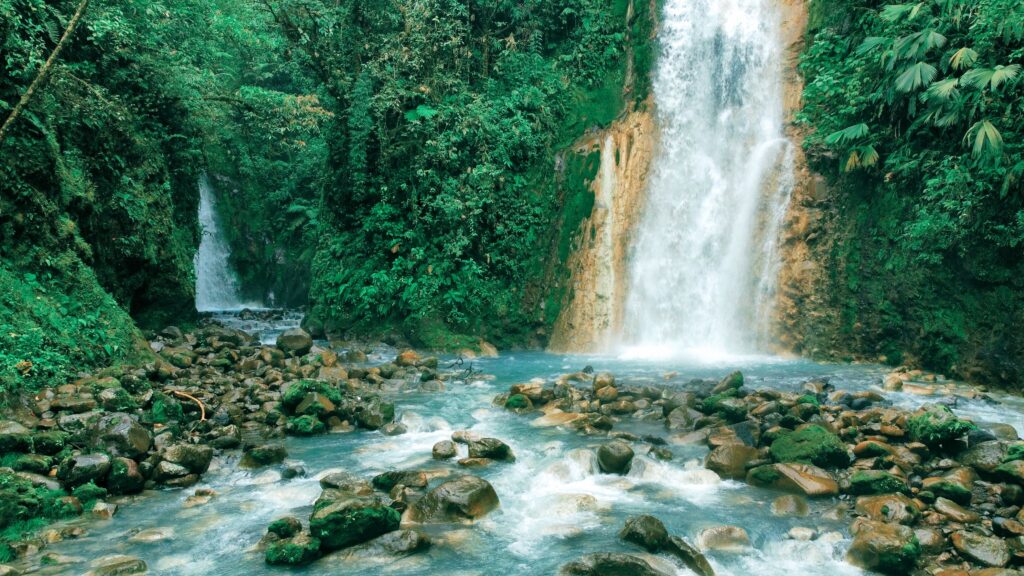
Alas del Destino Butterfly Garden
While heading towards our hotel, we stopped in the small town of San Carlos to visit a “mariposario” or Butterfly Garden. We were coming a bit later in the day, so we were lucky to catch the last tour before it began, as the owner was still waiting for someone who had booked tickets online. Once everyone was there, he explained us the stages of the butterfly development, from the eggs to a caterpillar, a crysalis, and finally, a butterfly, and showed us examples of each category. He also went into the challenges of egg fertilization, parasites that can infect the butterflies, or even how to maintain enough genetic diversity. We also learned about the butterfly business, how many places were buying the crysalids from him, while he raised the caterpillars.
In the second part of the tour, the owner showed us the lands where the caterpillars and butterflies live. We also could touch some of the caterpillars, which were really big, and at the end, we entered in a butterfly filled room, where we could put some of their food on ourselves so that the butterflies would pose on us.
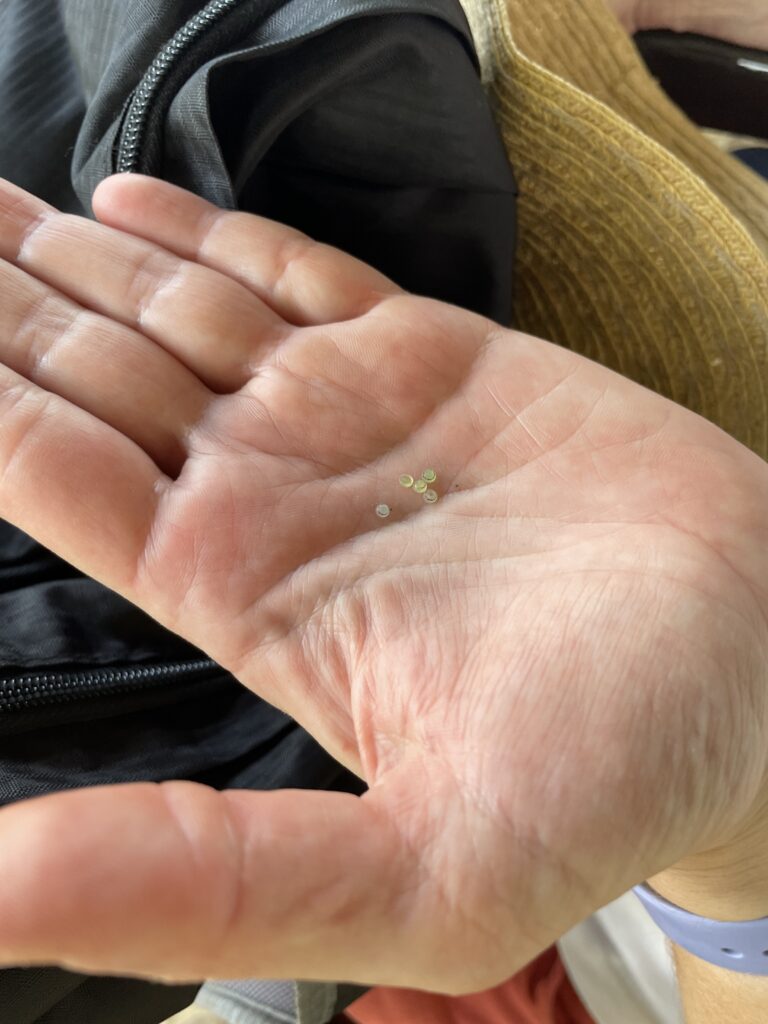
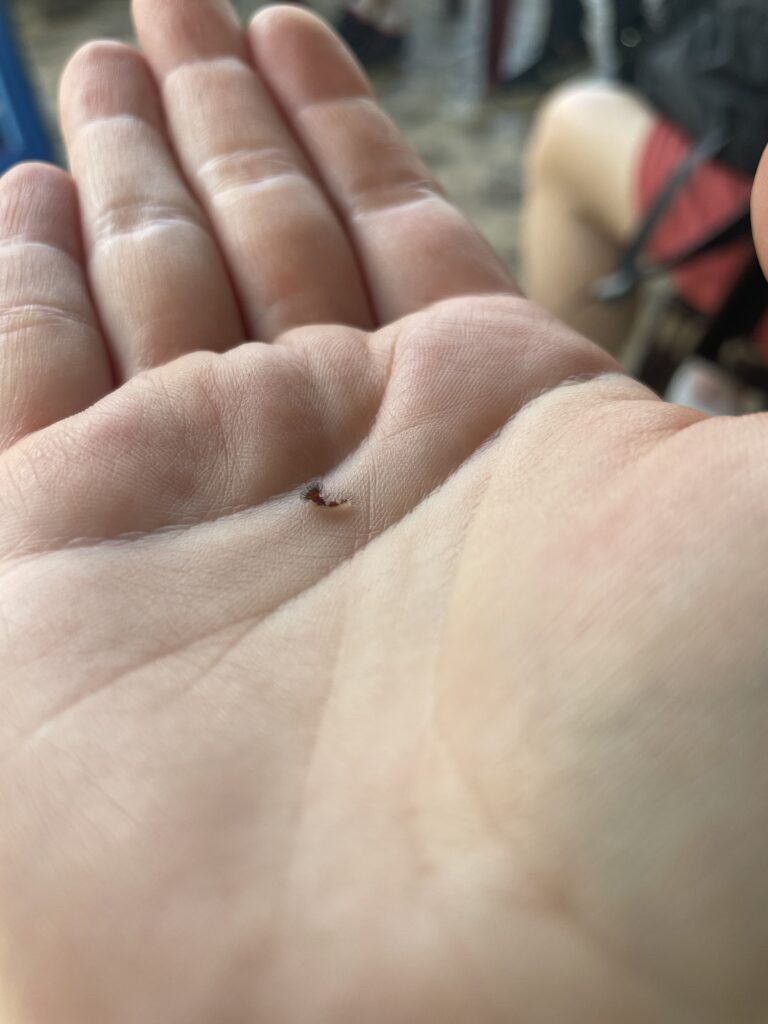
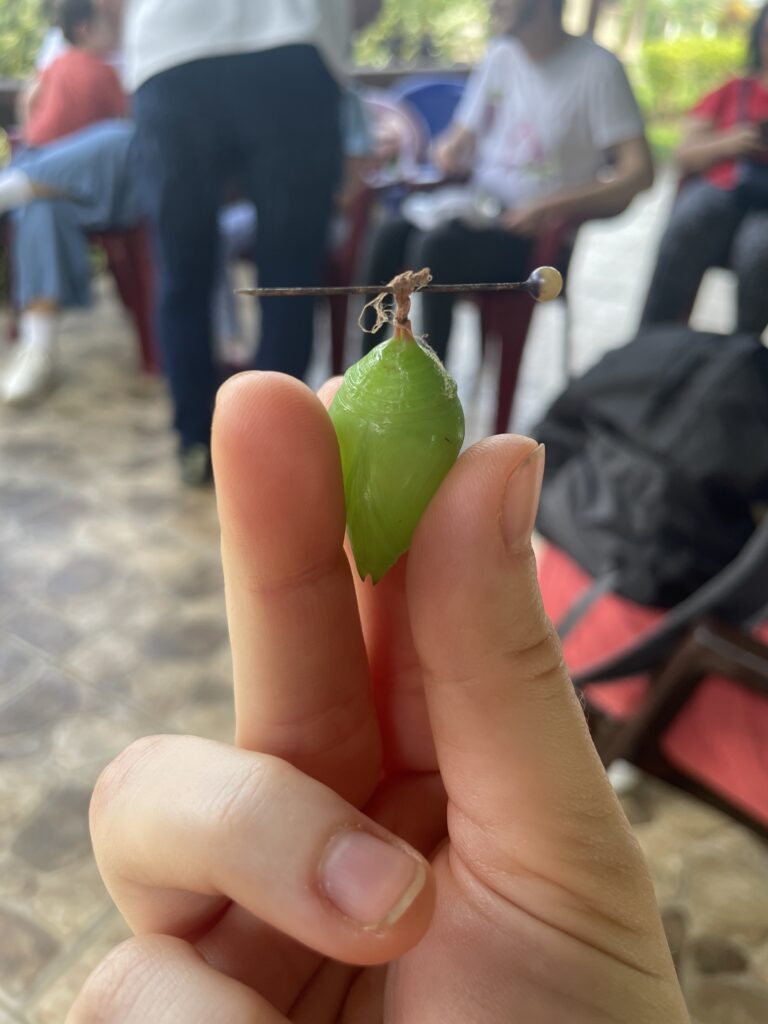
Hotel Recreo Verde
This was not the easiest to reach hotel, so we were glad to have a robust car. Probably even a standard sedan would do, but I’m more of a city driver, so driving in narrow, wet, and steep path is far from my comfort zone. However, what a cool hotel this was! An employee received us in the reception and showed a place to park. Then, he accompanied us to our own bungalow, which was a simple but comfortable room. It was getting dark already, so we didn’t get to explore much of the facilities in the evening. We just slowly drifted towards the bar, where we grabbed some drinks.
That was my first night sleeping in the jungle. I kept hearing howler monkeys screaming, while wondering what kind of animal were they (we asked reception next day). In the morning, we realised that there was no hot water in the shower, which was fun, and then we went to explore the hotel area. They had a few thermal baths, which were really great! Since we woke up early, there was still no one around, and we had the baths for ourselves.

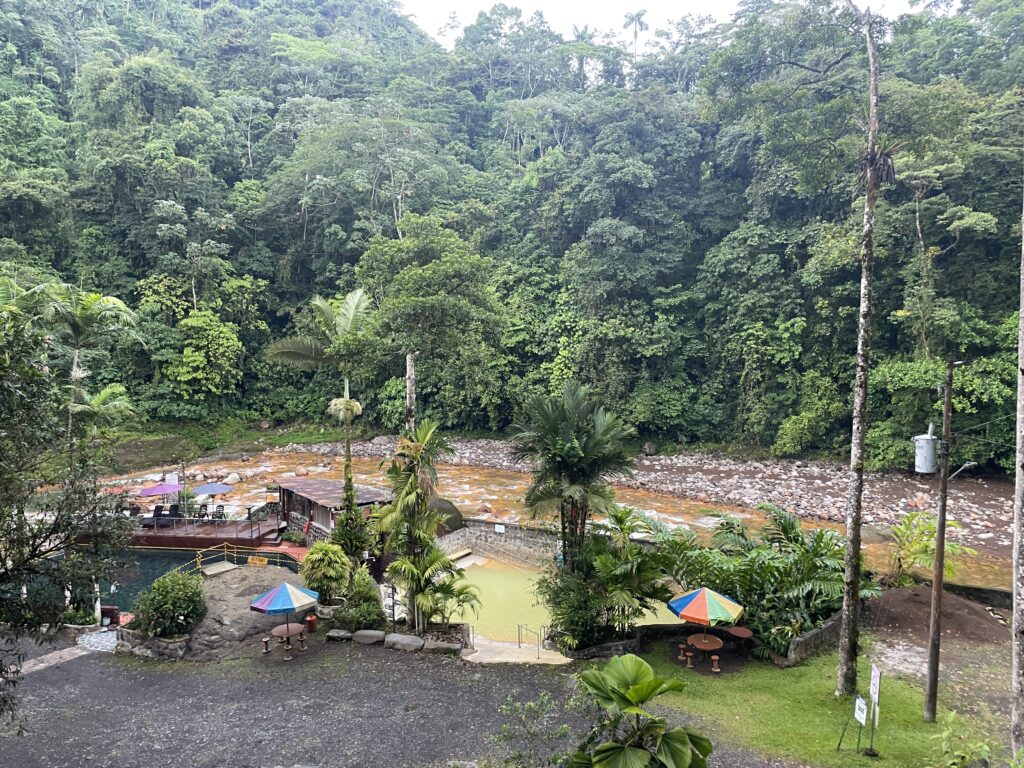
Day 3 – Parque Nacional Arenal & Chocolate and Coffee tour
Parque Nacional Arenal
Arenal is an active volcano that erupted in 1968, forming three new craters and killing 78 people. The volcano erupted until 2010, and is since then a dormant volcano, which you can visit. The volcano region is a National Park with several trails you can visit after buying a $16.95 ticket. There are two main regions from here to hike, the Volcano sector and one sector near a dirt road.
We started with the Volcano sector, walking all the way through Las Coladas path to reach a lava flow from 1992. The path is very well defined, with a rich vegetation surrounding it. Once we reached the lava flow field, we had nice views of the Lake Arenal and also of the volcano. After returning, we did the car trail (number 6), which brought us to a view point. The view was quite similar to what we had already seen. Our final hike was trail 1, Los Miradores. To reach it, we had to drive 2 km through a dirt road, which was far from pleasant. The hike itself was quite nice – we could hear the animals but didn’t really get to see. At the end of the path there is a viewpoint of the lake with a platform to get a bit more into the water. When we visited, most of the platforms were under repair.
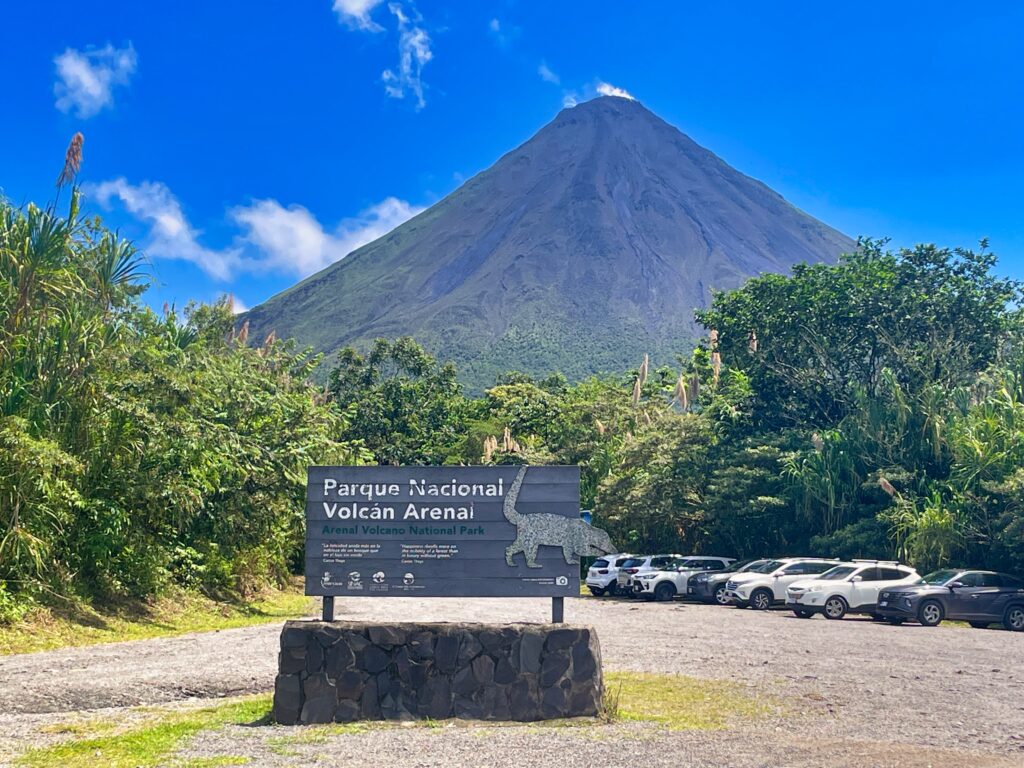

Chocolate and Coffee tour
We drove to La Fortuna for a quick lunch before heading towards the Chocolate and Coffee tour with North Fields. Our guide showed us how chocolate is made in Costa Rica, and more importantly, we got to try some delicious samples. We then walked to the coffee plantations, and on the way, our guide found a red-eyed tree frog, Costa Rica’s most iconic animal.
We then got to learn about coffee. Costa Rica has small plantations, so they specialize in high quality coffee export. We then got to try some of their coffees too. It was a cool tour, where I learned a lot about the coffee and chocolate plants, and their production process.
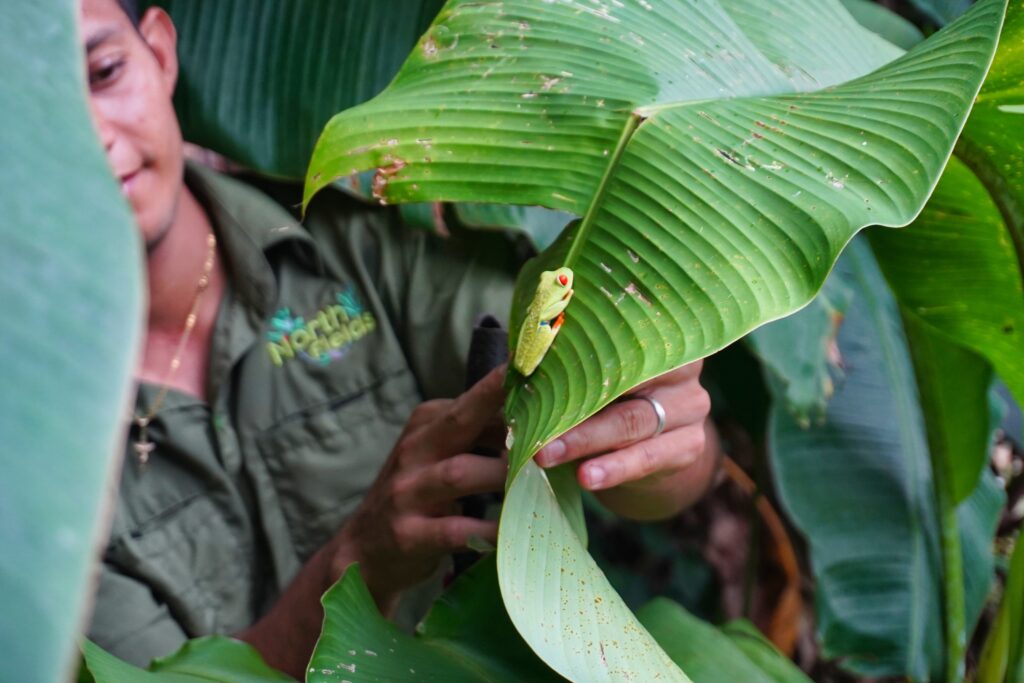
Casa Luna Hotel & Spa
Our next hotel was also great. The rooms were cozy and clean, but the best was the facilities. We had views of the Arenal volcano from our room, as well as a lush green garden. The food served in the hotel was tasty and varied, and we got to do a massage in the facilities too, apart from enjoying the swimming pools.

Day 4 – Caño Negro
While we initially had planned to continue hiking in Arenal, we already saw everything we wanted to see the day before. Thinking of ideas, we checked with our hotel, which was offering some tours and we decided to follow the recommendation of the receptionist and get the tour to Caño Negro. Caño Negro is north of the country, over 2 h away from La Fortuna, really close to the border with Nicaragua. Some other tours offered crossing the border, but we opted out of this as they were generally longer, and Costa Rica had plenty to see as well.
While I wasn’t initially hyped about the tour, since it was promising to put us on the boat and see animals, it turned out to be very cool. We navigated in a boat through Rio Frio, and our guide pointed out towards many animals. Most of the animals we saw were different types of birds (birding is a big thing in Costa Rica), but we also got to see some sloths, monkeys, reptilians, and even bats sitting on a tree. Here we learned that there are two types of sloths in Costa Rica, the two-toed and the three-toed sloths. Apparently there is a bit of geographical distribution of the sloths, and in this region two-toes ones were more common.
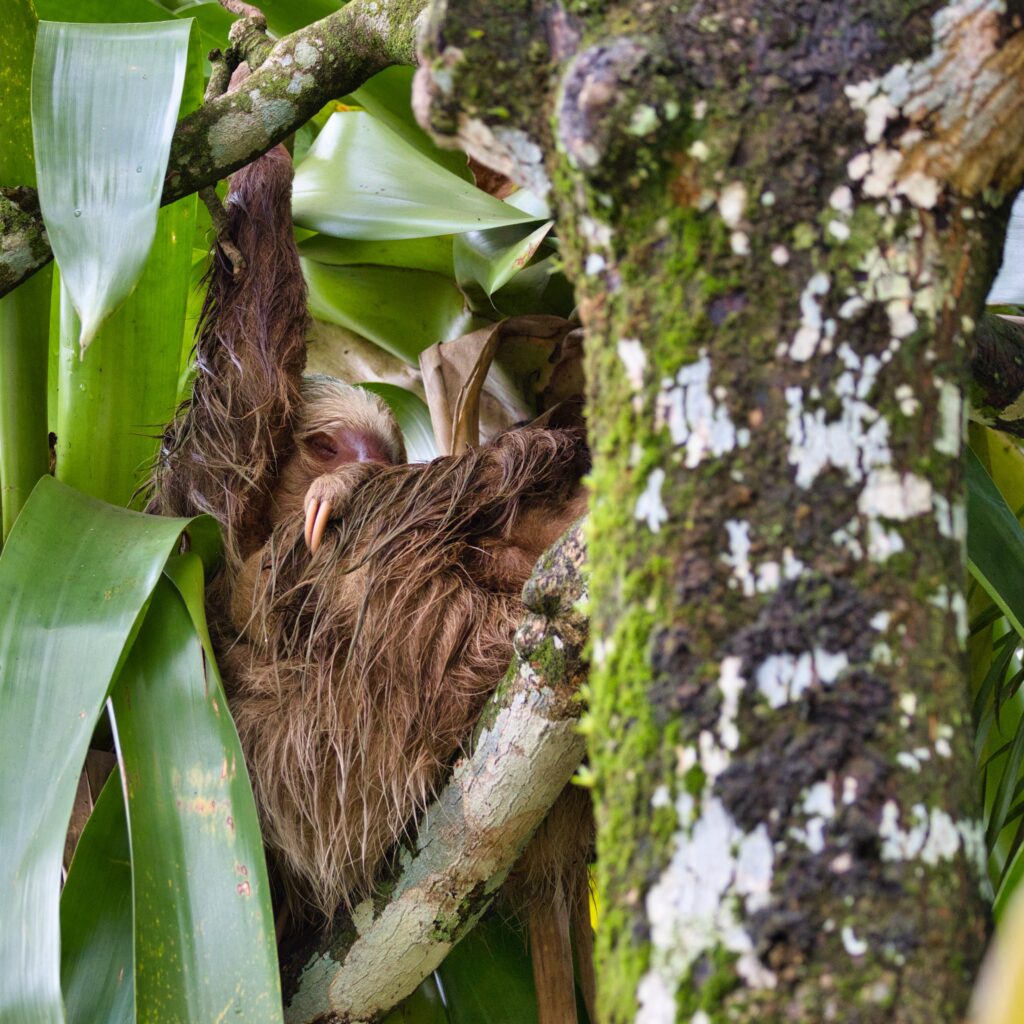
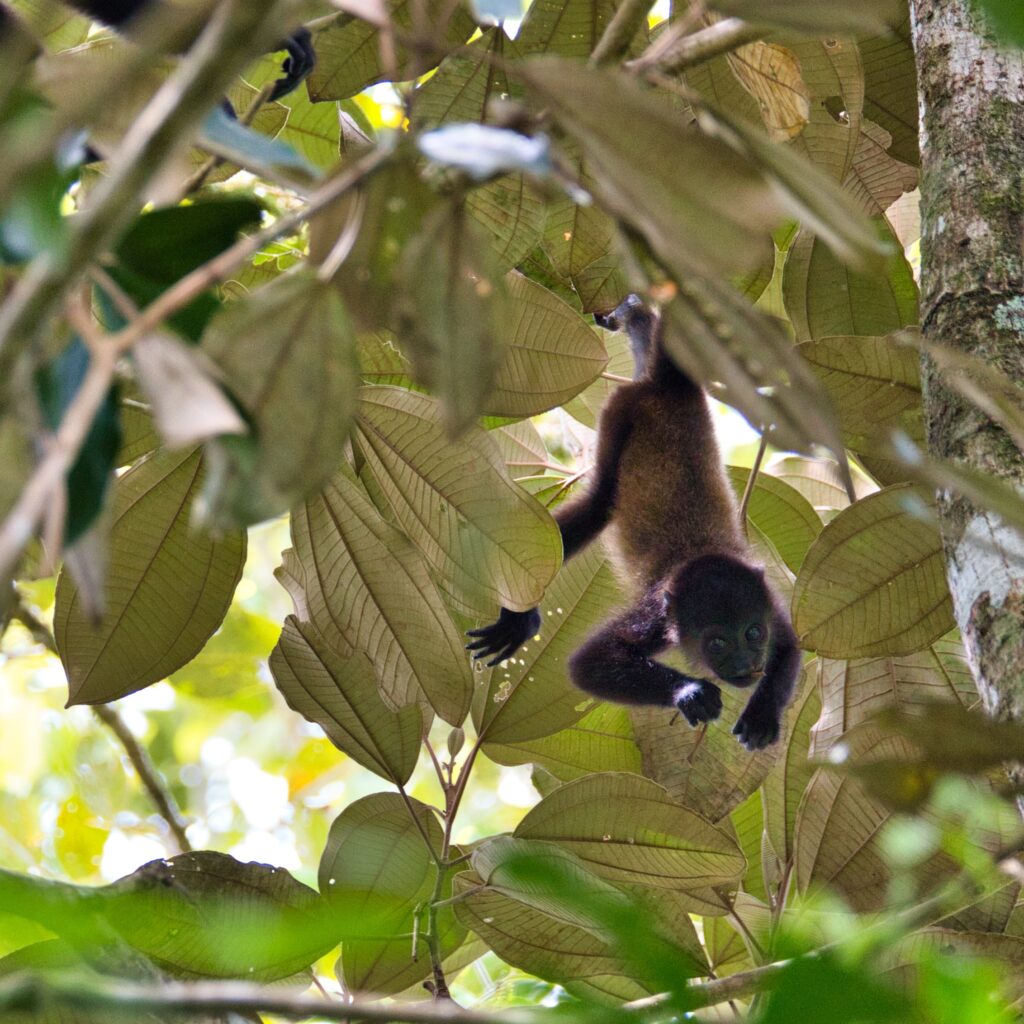
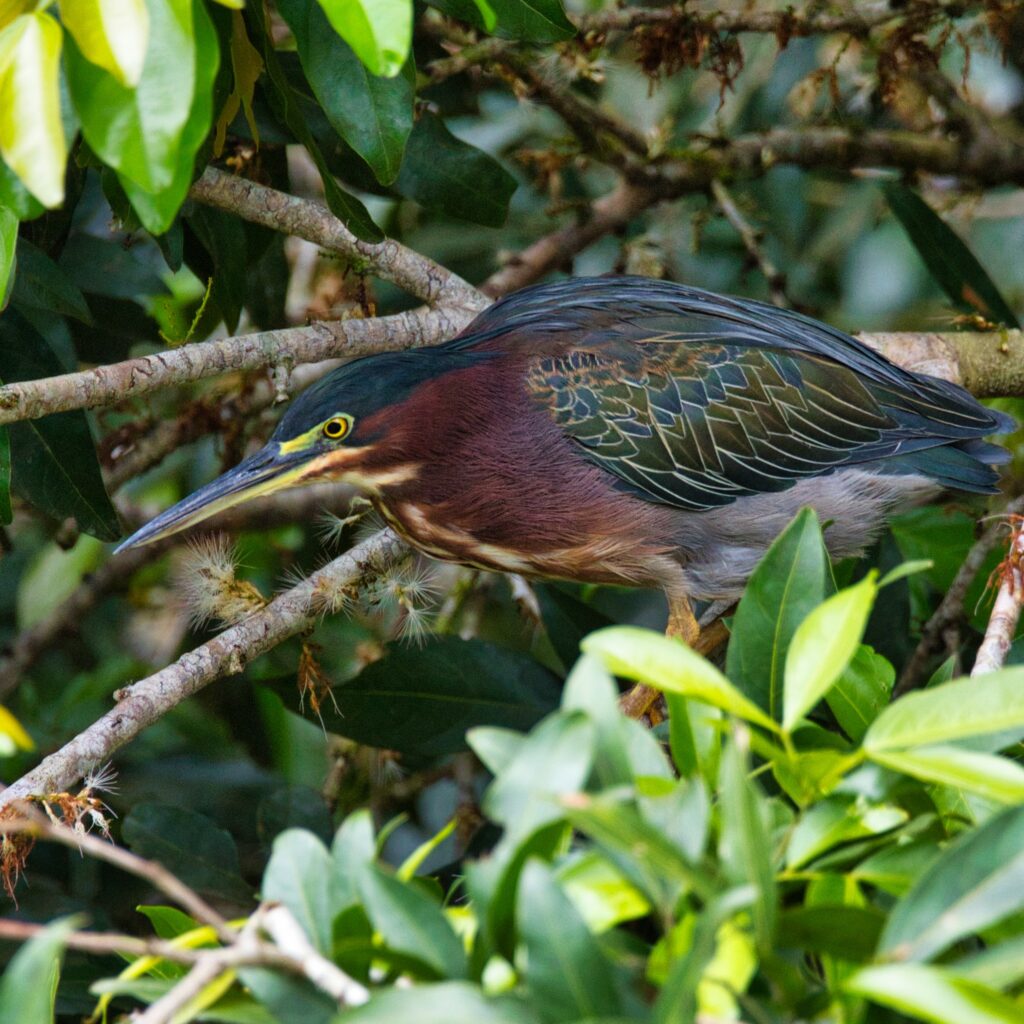
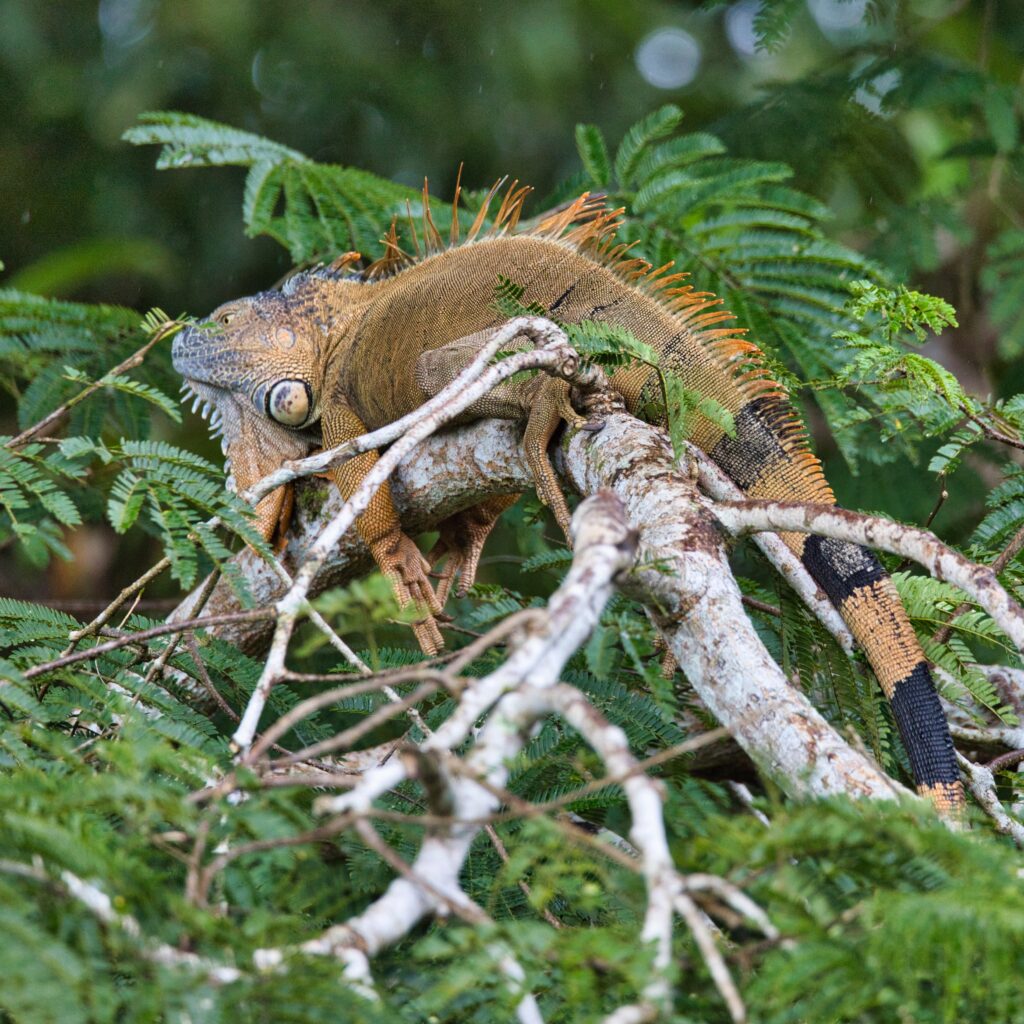
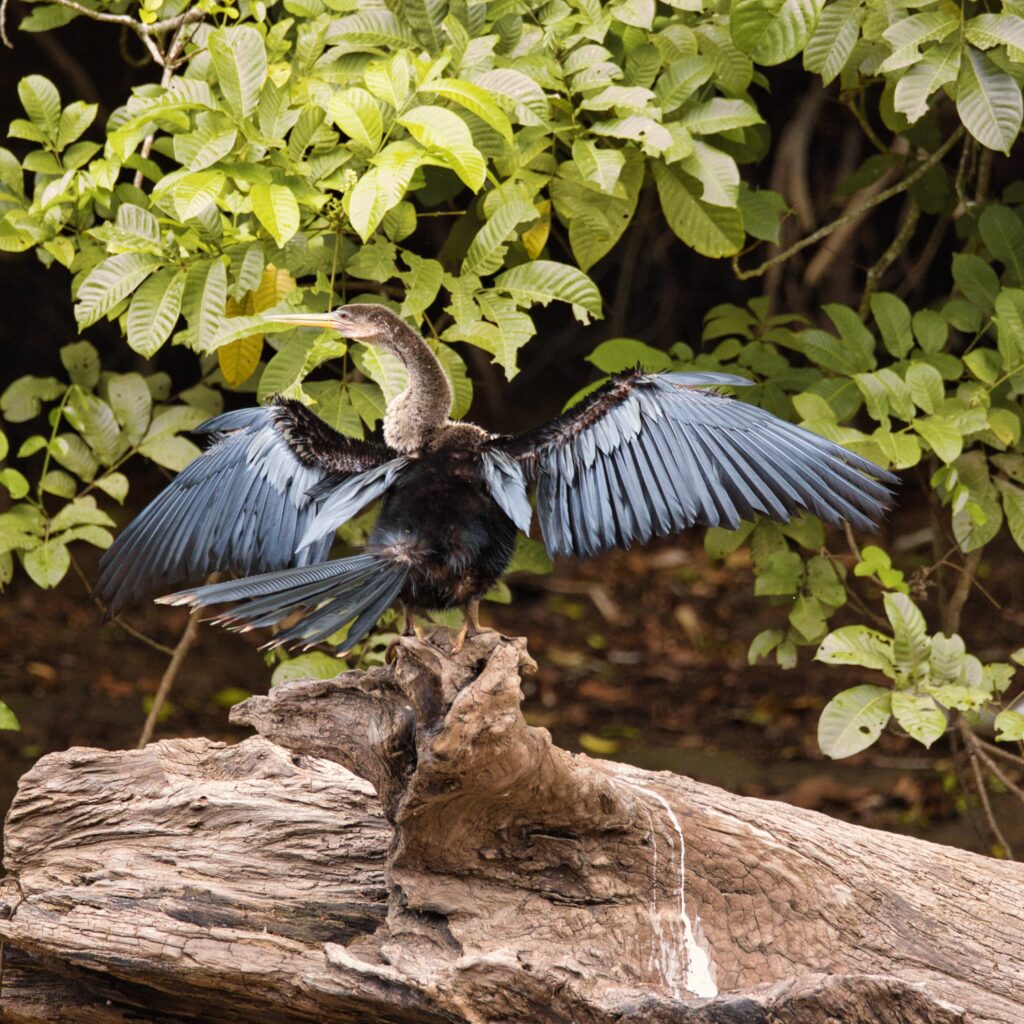

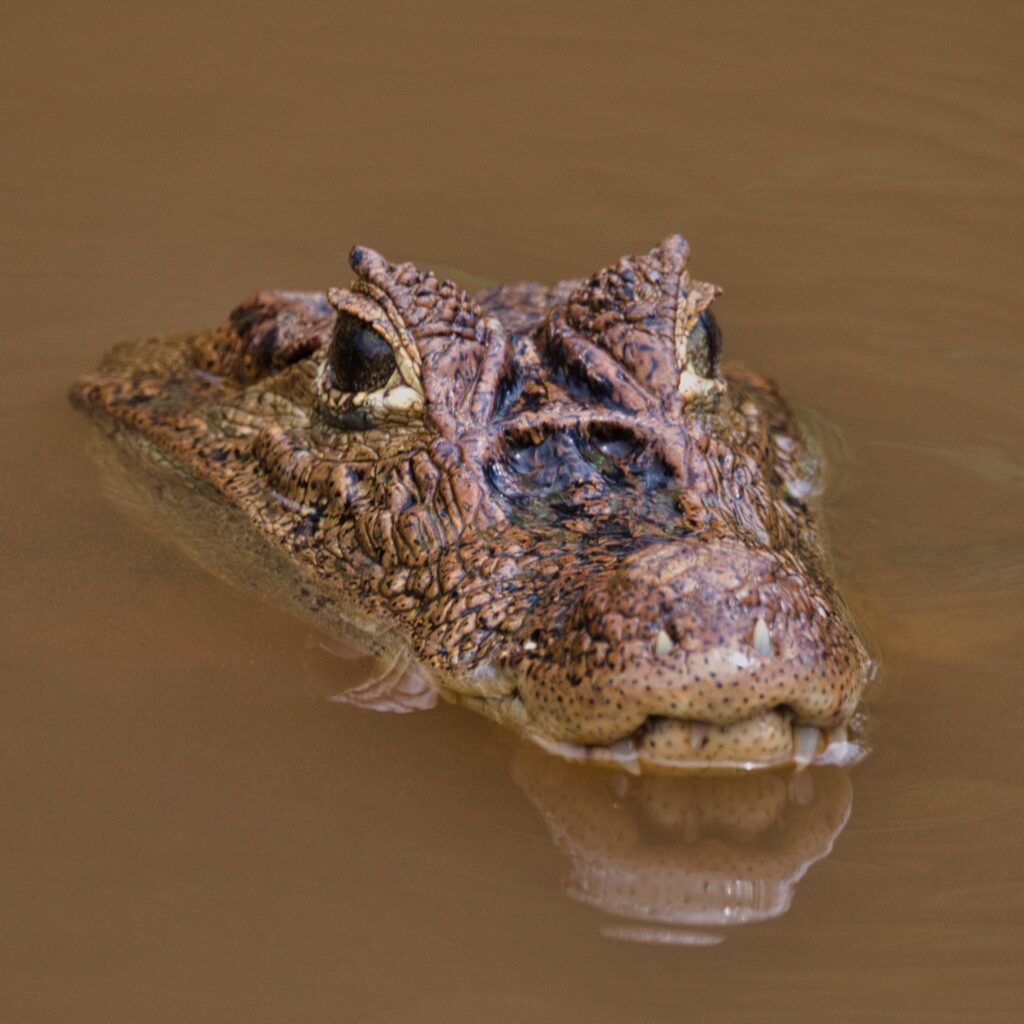
And every move you make
I’ll be watching you
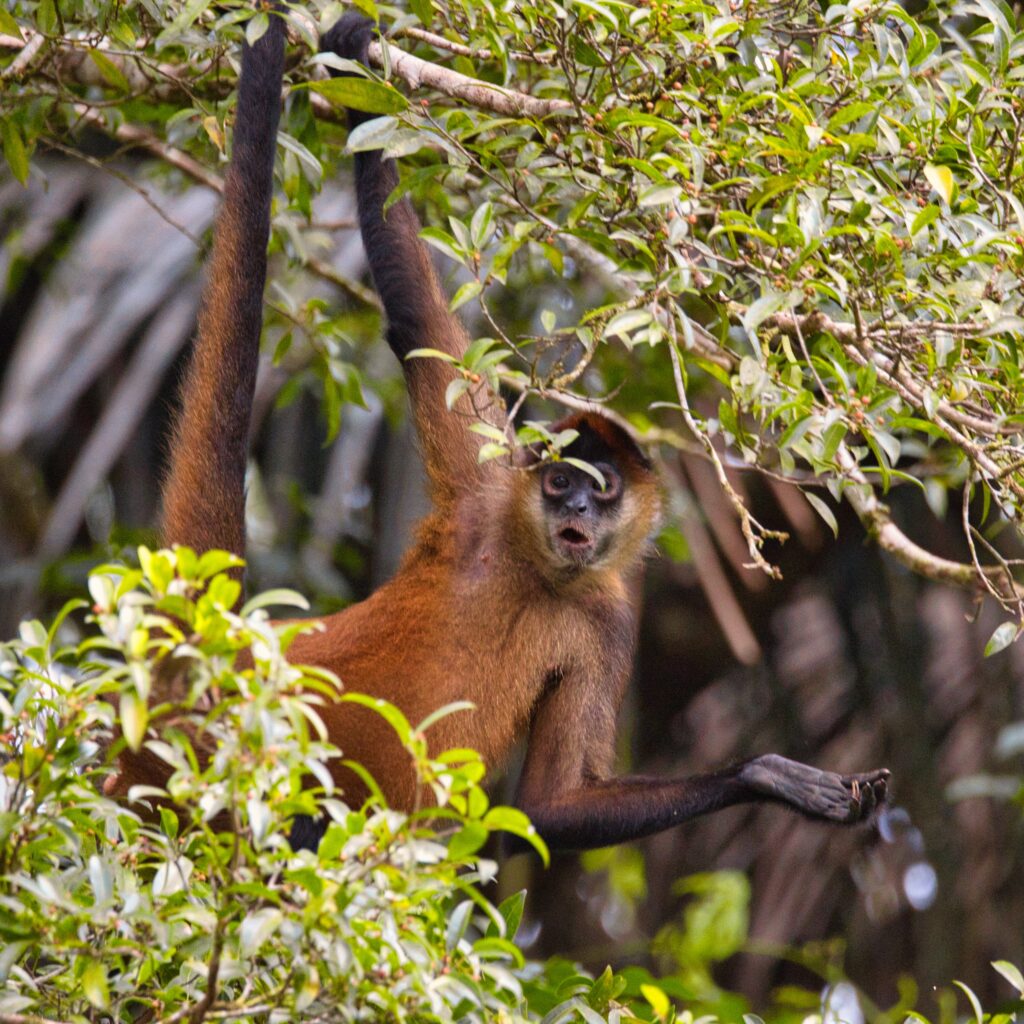

Dinner in La Fortuna
While the tour obviosly included lunch, we were back to La Fortuna for dinner time. We went to the Restaurant Nene’s, a steak house where we ordered a salad and some fried shrimps that were really tasty.
Day 5 – Monteverde: Selvatura Adventure Park
In the morning we headed out to Monteverde The roads to Monteverde were narrow and the speed limit low, so despite the not-that-many-km, we still took a bit more than 3 h to get to Santa Elena, where our hotel was. Additionally, the weather was not helping, at all. Until this day, while there had been some showers, they were not really stopping us from doing anything. The rain in Monteverde was different. It was intense.
Selvatura Adventure Park
Something typical to do in Monteverde is to see the hanging bridges over the cloud forest, a very biodiverse area. We initially wanted to go to the reserve but didn’t get tickets, so had to look for alternatives. The one we found was the Selvatura Adventure Park, which was a cool alternative, albeit a (very) expensive one.
Our ticket included a hanging bridges hike, which were really cool. I do have some fear of heights, and I had no issues crossing them. My companion was more afraid than me in that regard, and she had some issues with some of them, although she also enjoyed the experience. Just so you know, the bridges do move a bit when people cross.
Seeing the jungle below you was astounding – it’s crazy to see so many plants right below. We were walking above the trees and could see how the clouds were approaching us. While on this tour, an episode of strong rain started, and we had to rush to the end of the hike to get some protection. It almost looked like there was water being poured from a bucket.
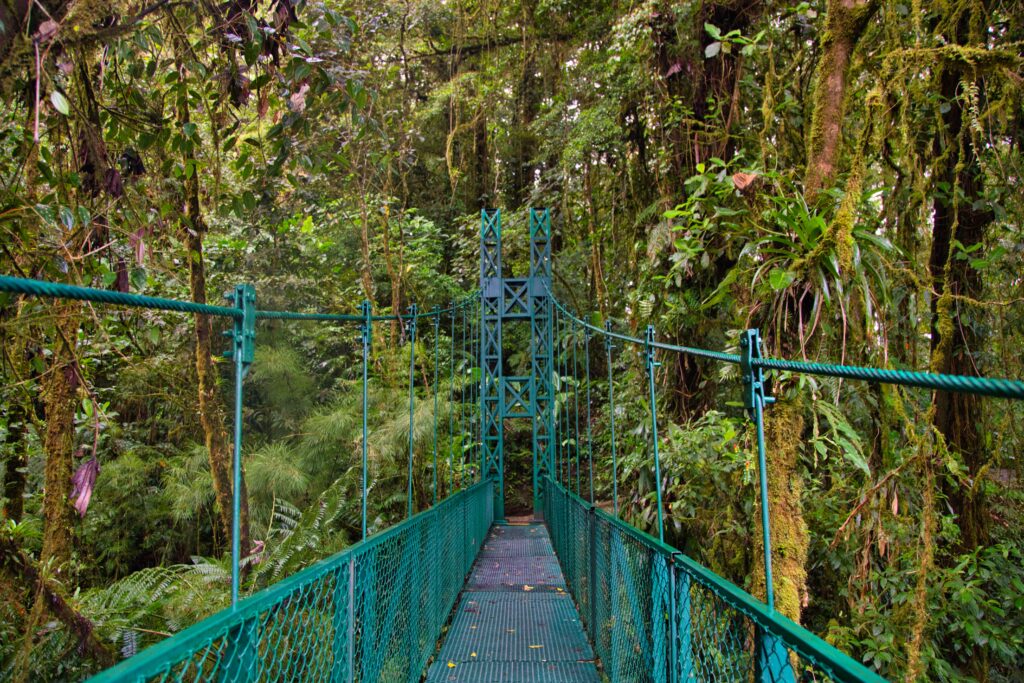
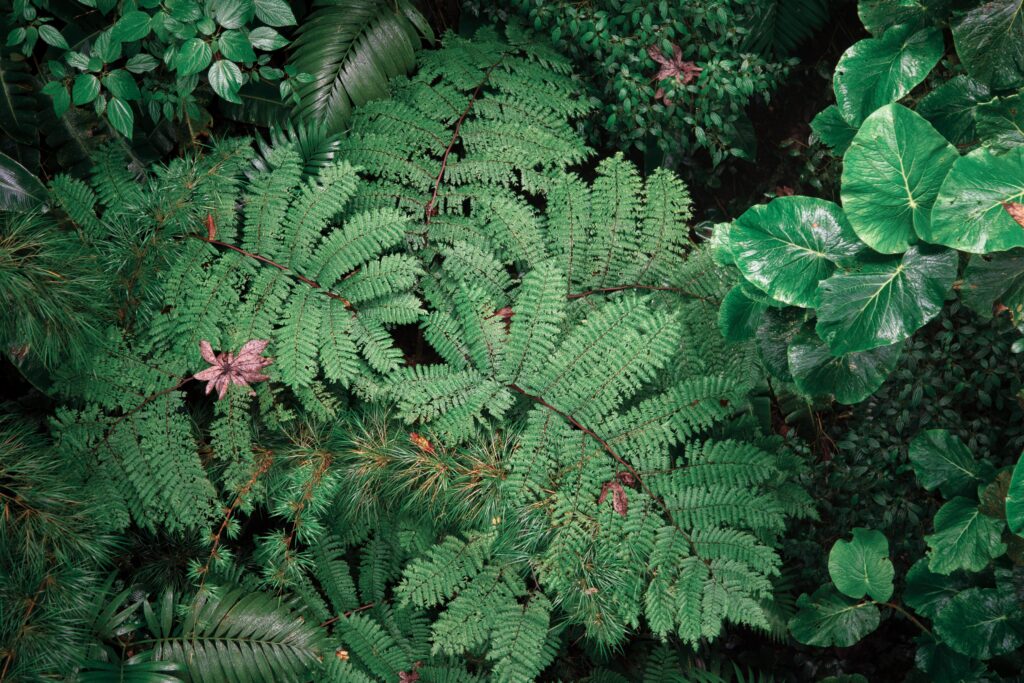
While in Selvatura, we also visited the sloth recovery center, where the guide explained about the sloths that they had and about their lives. My favorite part was seeing how a sloth thought that there was food, moved one step towards the plate, realized that there was no food, and went back to sleep.

Monteverde
While we would have loved going somewhere (anywhere), the furtherst we ended up was a restaurant to have something to eat before running back to our hotel room. The rain was extremely intense, making it very unpleasant to be outside. We took the chance to relax a bit and catch up on some sleep.
Day 6 – Monteverde: El Tigre Waterfall, the Bat Jungle, Orchid Garden, and el Ranario
El Tigre Waterfall
This was one of the tours that I was really looking forward. In the morning, we drove to El Tigre waterfalls, reaching an ample parking at the end of a dirt road. The parking was right next to the main building, where the receptionist gave us the instructions to visit the place and a stick to help with the hike.
The trail was very easy to follow and wasn’t challenging, going mostly downhill. The total length of the hike is 8 km, but you have the option of doing 5 km walking and then take a horse to bring you uphill, which is the option we took. The trip was really cool, with several waterfalls and tiny bridges to cross the water. The horse experience was also quite fun. They assigned us horses, and after we sat on them, the horses already knew their way, so they would start going. My horse turned out to be the self-procclaimed leader: despite me being sat the last one, the horse made its way through to the front by pushing everyone else aside. It then competed with another horse, who also wanted to be first, but mine ended up winning. I had to wait quite a bit until my companion was back, as her horse was one of the slowest ones.
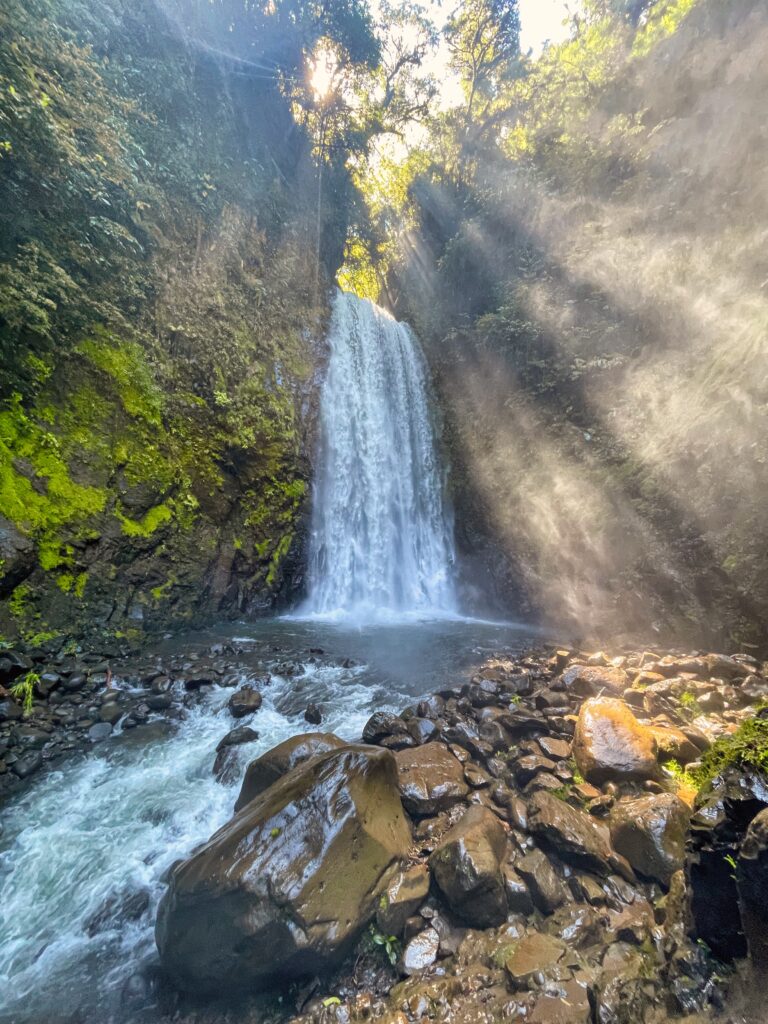
Adventures in Monteverde: Orchid garden
After finishing our lunch in El Tigre waterfalls, we headed to Monteverde. Fortunately, the weather wasn’t as bad as the previous day, and while it was still raining, we got the chance to visit some more places. Our first stop was the Monteverde Orchid Garden, which features over 450 species of orchids. It was super interesting to see all these different types of orchids, many of which I would have never guessed were form this family. They had some tiny orchids that were really cute too. The lady from the garden gave us great explanations of the different orchids, as we were alone with her because of the rain.
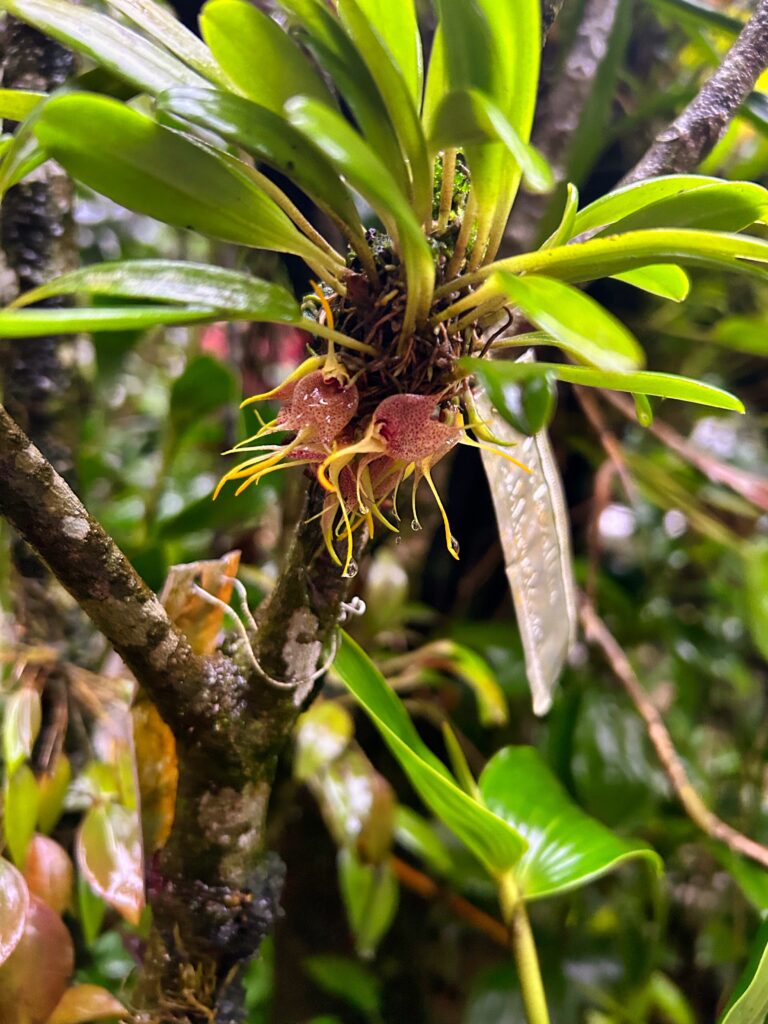
Adventures in Monteverde: Bat Jungle
One of the guides in Selvatura recommended us to visit the Bat Jungle, to learn more about bats and enjoy the explanations of the owner, who is a scientist specialized in bats. Unfortunately, we arrived late for the tour, so we went in by ourselves. It’s a relatively small museum, where the most interesting part was the room with bats. They were really cute, hanging around the walls or eating fruits, while pretty oblivious of our presence.
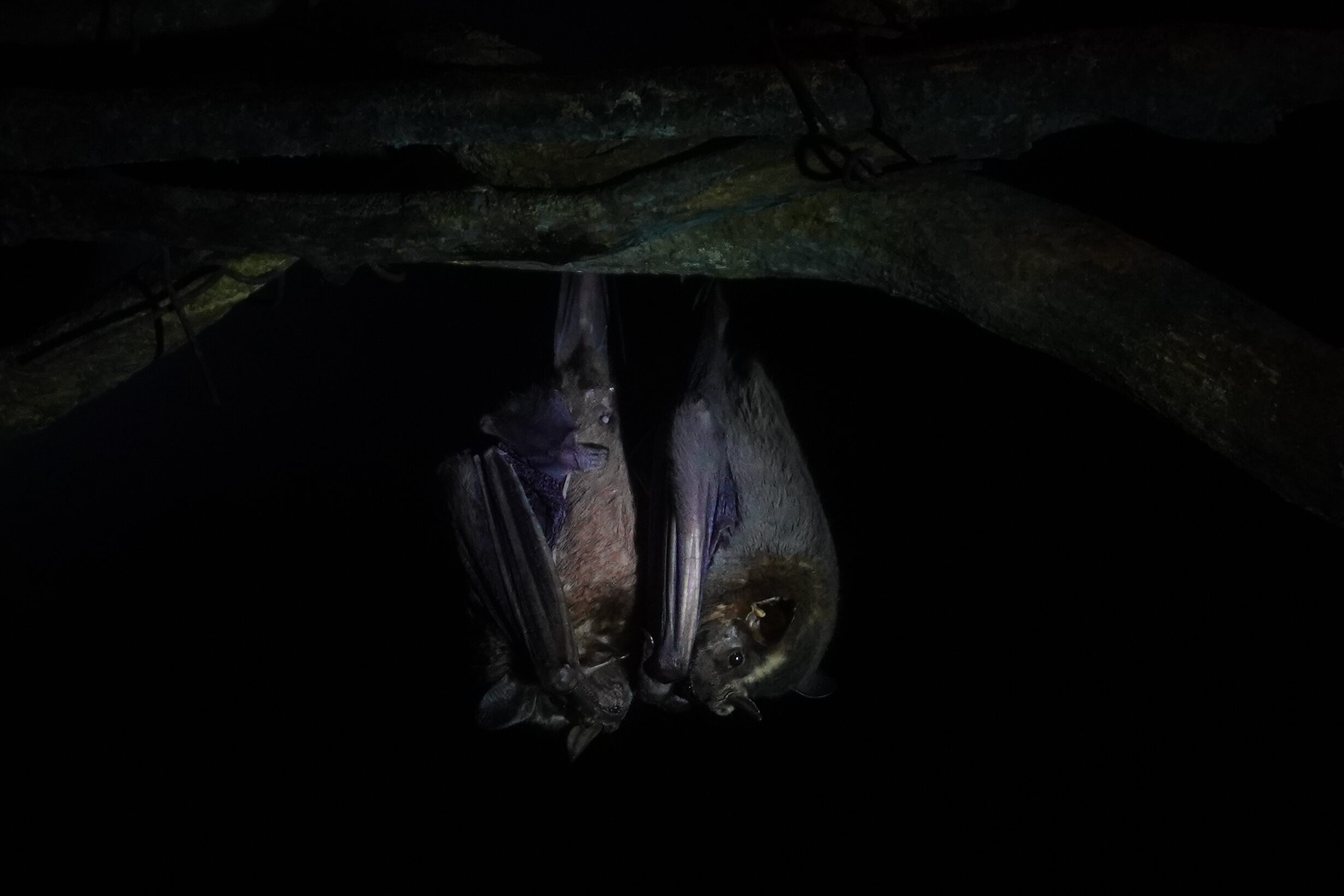
Adventures in Monteverde: Ranario
Our last point was the Ranario, where you could see live frogs in transparent cages. One of the employees of the place helped us finding some of those, as they sometimes can be really good at hiding. In the room leading to the Ranario, there was a small exhibition of dried insects, mostly tropical butterflies that was also quite interesting, although you could see that the specimens were quite old and not always well-preserved.
Day 7 – Towards the South: Parque Nacional Carara and Jacó
Parque Nacional Carara
While planning the trip, I didn’t book any tours for this national park, thinking that I could save the money. However, after seeing el Caño Negro, I suspected that a guide was essential to see any animal. I checked online and found that in TripAdvisor they specifically mentioned a guide, Mauricio, who would usually wait at the park entrance and ask whether someone needed a tour. We were lucky and when we came he was there.
Carara doesn’t really have any special highlight, it’s a forest. Without Mauricio it would have been the most boring experience, but thanks to his expertise we had a great time. He found plenty of birds, which he could identify by the sound, and also showed us some animals with the portable telescope he had. His explanations were great, so the tour was a blast. My proudest moment was to see a snake before Mauricio did, but that was the only animal I managed to see without lots of indications.
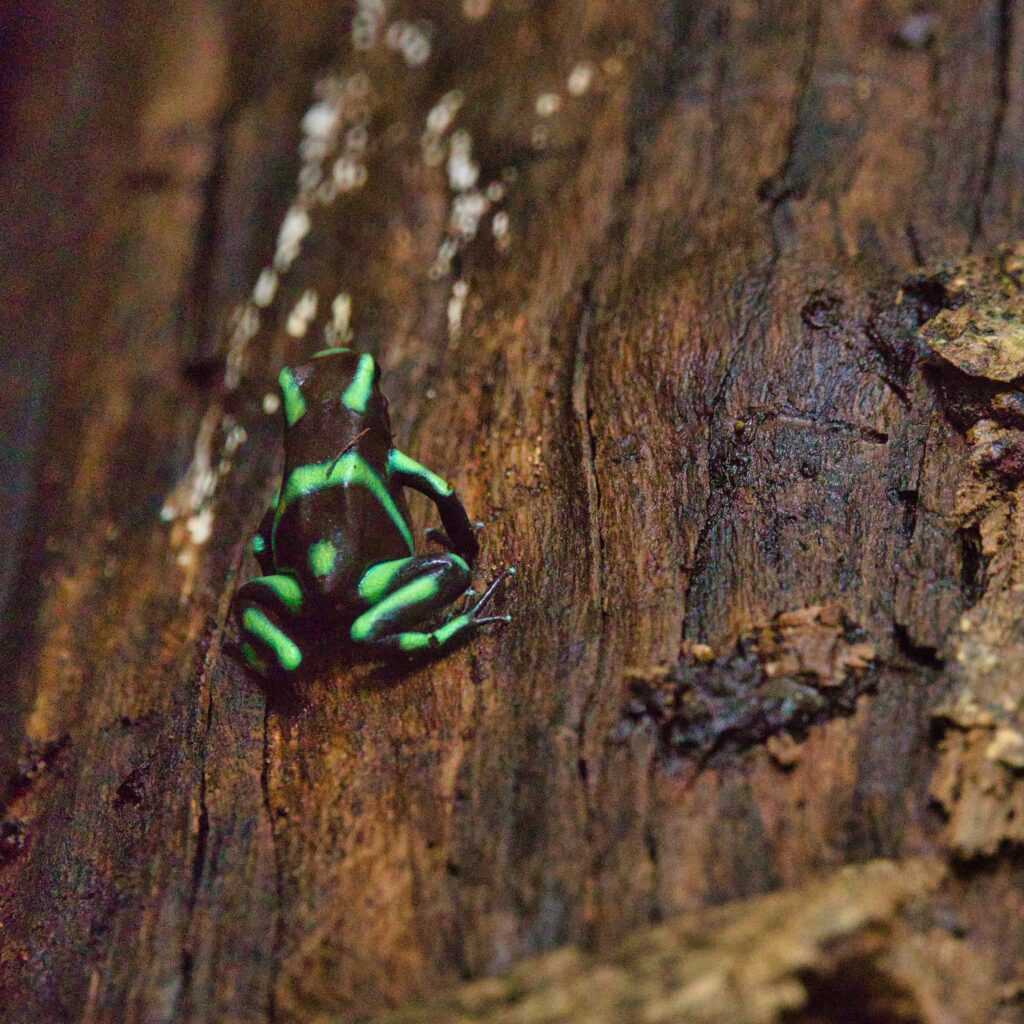
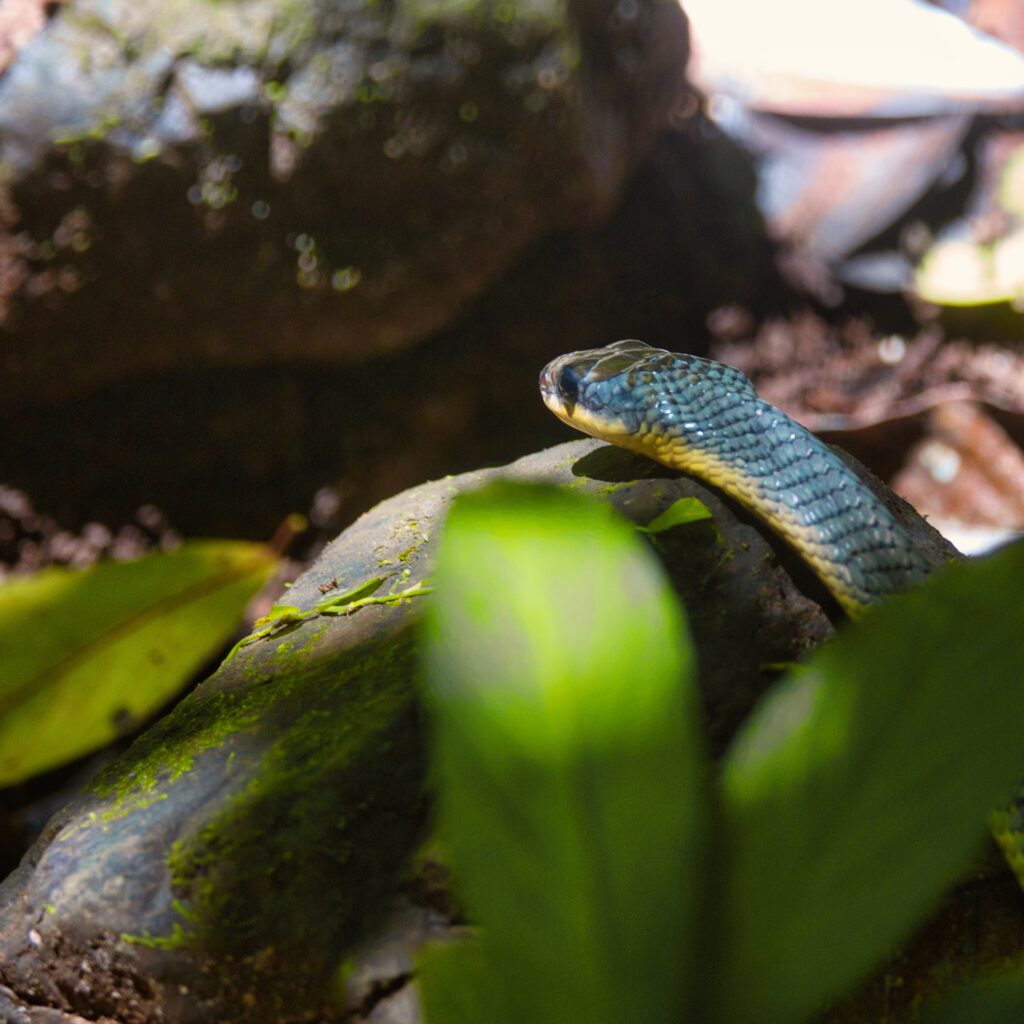
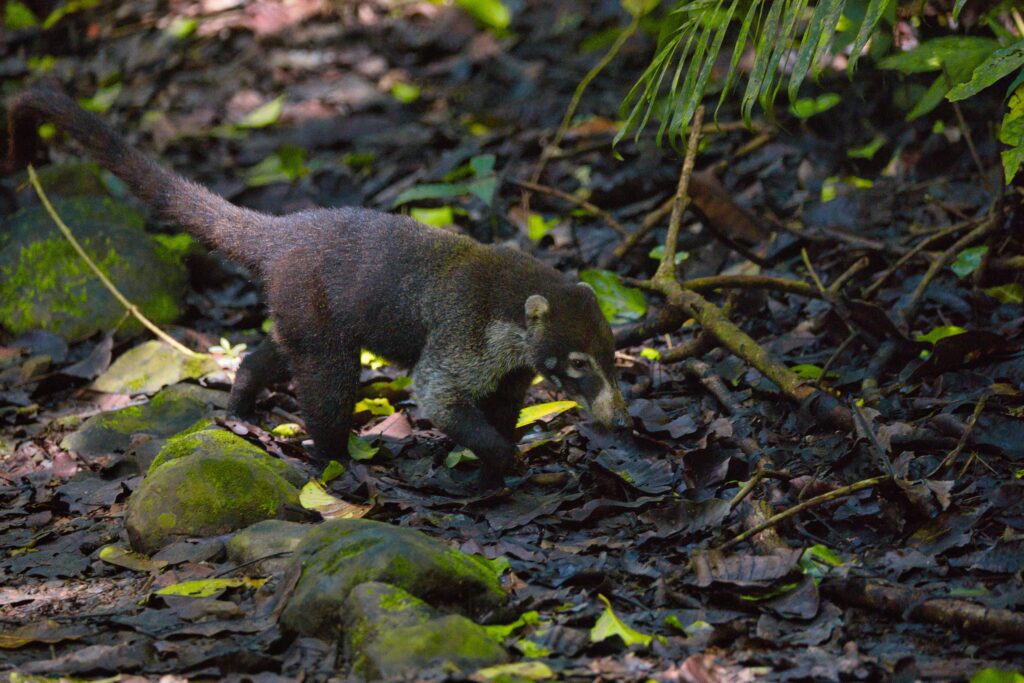
Crocodile bridge
After finishing the Carara tour, we drove to the crocodile bridge, a place were you could see the crocodiles from a bridge, as the name says. There were quite a lot of them chilling in the river, and the area around was well-developed for tourism. I wouldn’t say it’s a must-see, but it’s a nice stop. There were some ok restaurants for lunch too.
Jacó
We then drove to Jacó, located around 30 min south from the national park. I have to admit that I was rather unimpressed with this city. It was quite a typical touristic place, but also felt a bit unsafe when we wanted to enter the beach. We saw few drug dealers, prostitutes, and suspiciously-looking dudes around, despite arriving early in the afternoon. The beach itself was also not very pretty, with many logs and small branches making it look dirty.
We drove a bit away from the city, towards the JACÓ sign, where there are a couple of trees full of scarlet macaws. They were really fun, and were flying very close to us.

Night tour: seeing turtles laying eggs
In the morning, we had agreed with Mauricio to take a night jungle tour with him. After spending some time in Jacó, we were a bit bored and considered cancelling to drive to Manuel Antonio. So glad we didn’t! We met Mauricio in the center of Jacó after sunset, and he guided us the outskirts of the city, where we saw plenty of frogs, two sloths, a few reptiles, and an owl.
Mauricio proposed to drive to a beach to see if we could catch some turtles laying eggs, as it was the season for it. We walked on that dark beach, with no lights to have our eyes accustomed to the darkness, not seeing anything. Mauricio explained us all the dangers turltes were facing, from humans, who steal and eat these eggs, and other animals. After around an hour walking, and having already given up on our hope to see anything, Mauricio found fresh turtle trails, and indeed there she was! We watch from a distance how the turtle made a hole and started laying eggs. It was such an interesting experience! We were very glad we stayed, even when we ended up arriving quite late at our next hotel, La Vela Boutique Hotel – a beautiful hotel really close to Manuel Antonio.
Day 8 -Parque Nacional Manuel Antonio & night tour Rainmaker
Manuel Antonio National Park
I had heard mixed opinions about Manuel Antonio National Park before coming. Some of my friends loved it because of the amount of animals you could see, some hated it because of the amount of people you would certainly see. After some hesitation, we decided that since we’re here, we can as well do it. And as always – many places are touristic for a reason, so why not go. I think the mixed feeling of my friends translated well into what I also thought of the park after we finished: it was nice to see all the animals, but somehow it was the least authentic experience with animals we had until then.
Nonetheless, we got to see plenty of animals. We signed up for a tour at 7 am to be of the first ones to visit the park. Based on our previous experience, if you don’t know how to spot animals, you see none without a guide, so it was worth for us. Probably, in Manuel Antonio this principle applies less, as you can see where people are piling up and if you don’t have a guide, you still can listen around.
What we saw most of were monkeys, which were very confident (probably they got used to get food, which is now not allowed in the park), and would approach you. We also saw a viber, and many crabs. To end the tour, we walk towards the beach in the park. We jumped into the water, which was extremely warm, and spent some nice time there.
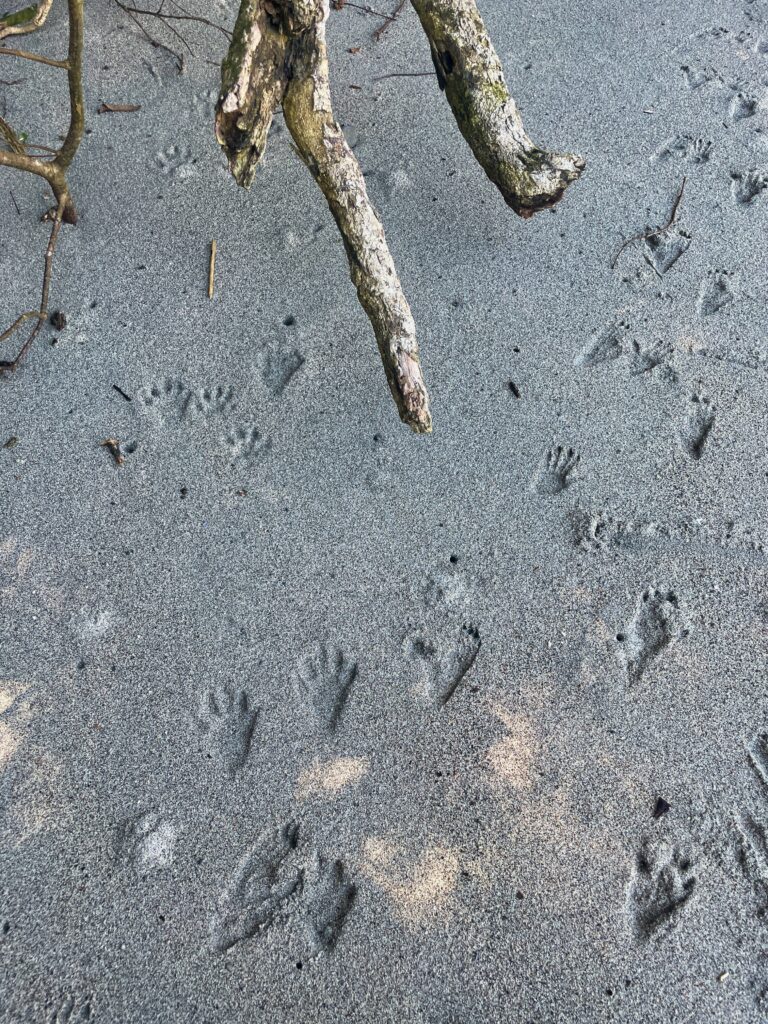
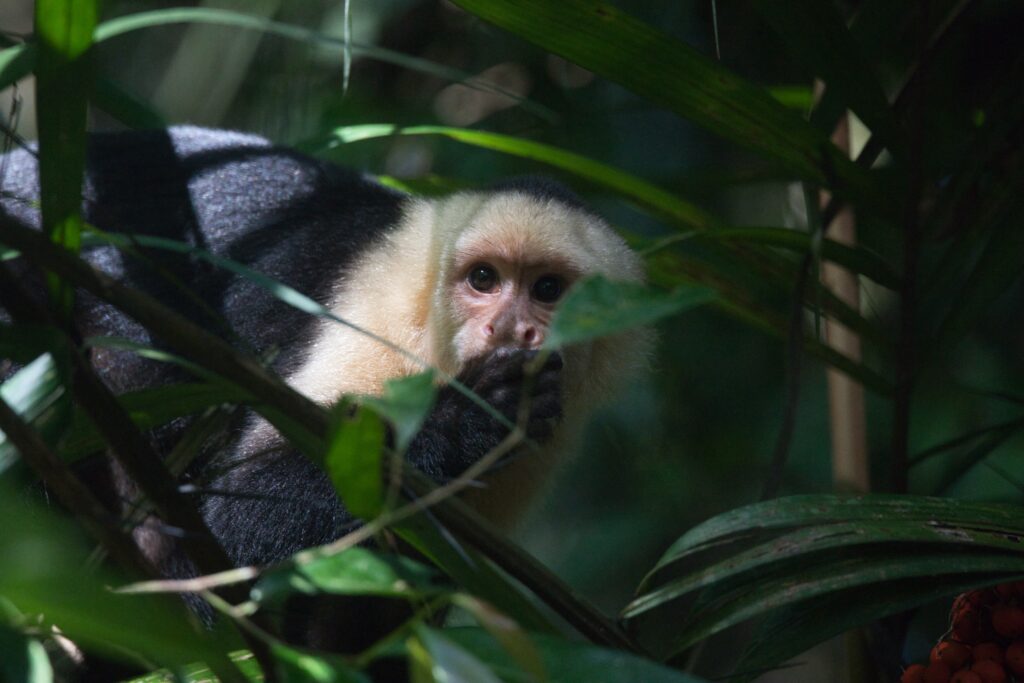
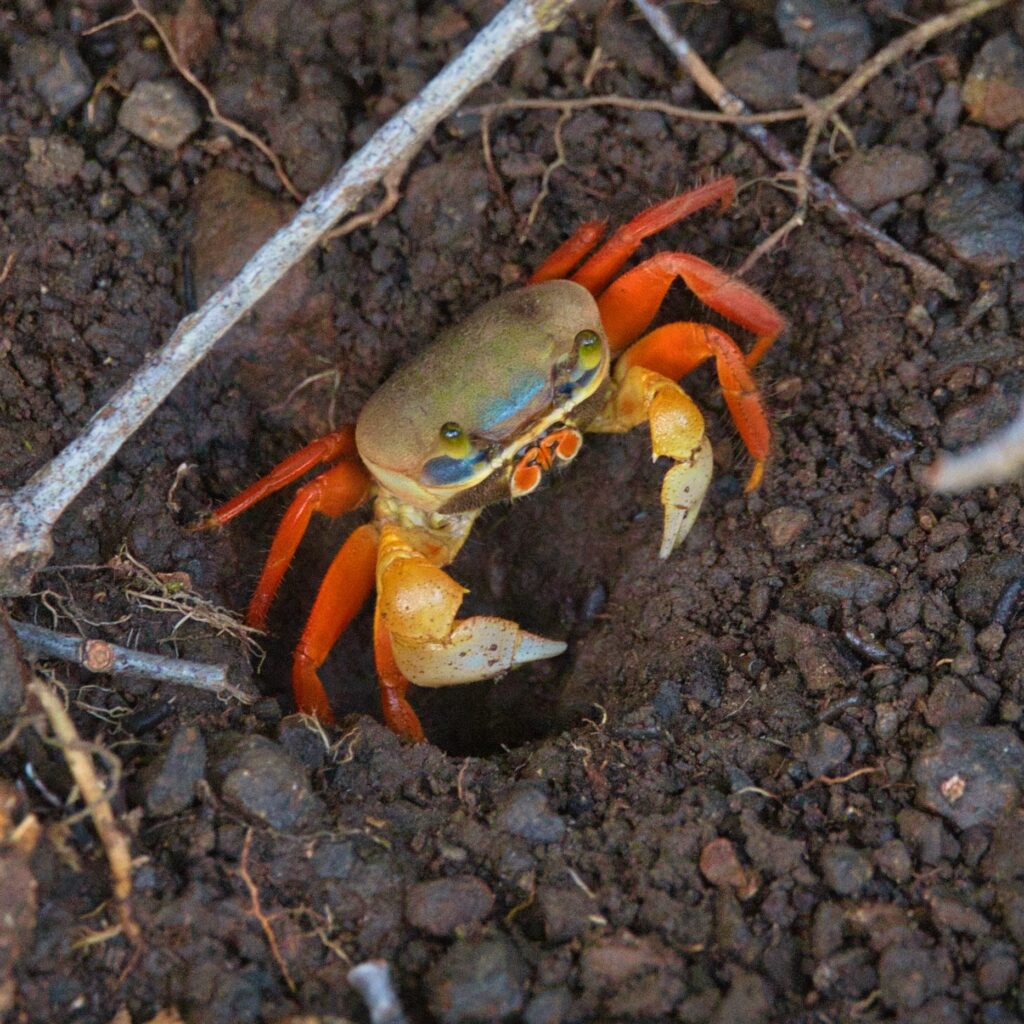
Rainmaker
After chilling around in the afternoon, we had another night tour programmed, the Rainmaker tour. Until the last minute we were not sure whether the tour would happen, as the rain had been quite intense. A couple who was expected to join the tour couldn’t make it due to the weather, so we had a private tour at the end. The guide drove us to the reserve, and fortunately, by the time we arrived, the rain had stopped a bit.
I’m always impressed how the guides manage to find any animal at all at night (except for the frogs, those are noisy), but our guide managed to show us several reptiles, many insects, and obviously a lot of frogs. We got to see the red-eyed tree frog well awake and making noises, which was really cool. We had a great time walking around the jungle at night, which was a bit scary at the beginning, as it is pitch black out there.

Day 9 – Parque Nacional Marino Ballena & Playa Hermosa
Our last day before heading back to San Jose was spent in the Marino Ballena National Park, located 1 h south of Manuel Antonio. Marino Ballena is famous because of the shape of the beach, which reminds of a whale tail. We hadn’t reserved any ticket for the tour and were lucky that the company still had some spots for us. They also had a very sweet kitten that played with the guests. We walked towards the beach and got into the boat. It started raining, so the waves were intense, and some people got sea sick. The boat drove around for a bit looking for whales and we got to see the backs of a mother whale with her baby. Then, the guides showed us some arches and nice features of the coast.
When we arrived back we were soaring wet, as the rain was quite intense by then. We got into the car and drove to a restaurant a bit on the mountain, recommended by the tour people to see the famous whale tail. Unfortunately, when we ended up in the lookout it was high tide, so we didn’t get to see the shape. However, the food was good and the views were nice.
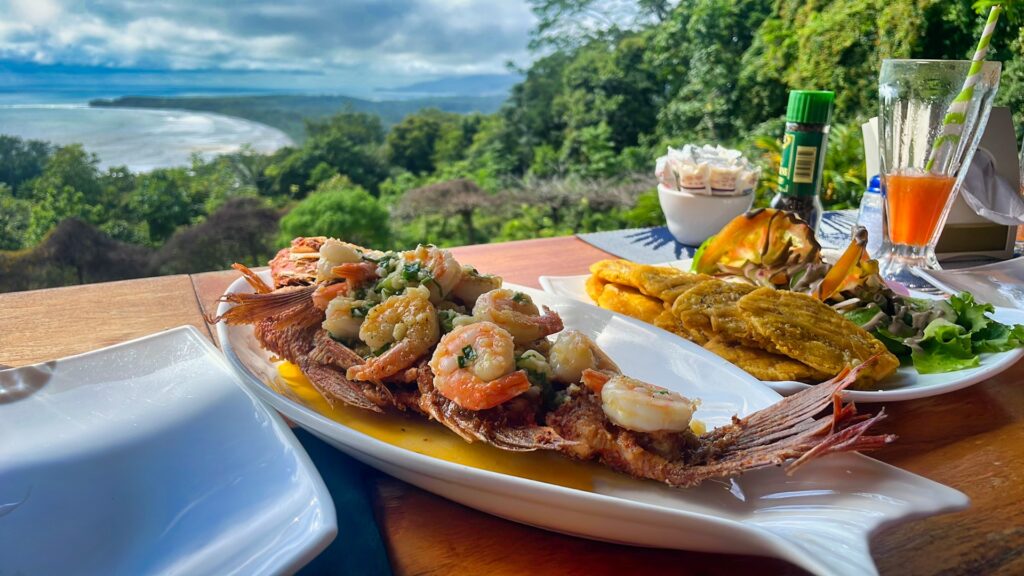
Playa Hermosa
Before driving back to San Jose, we stopped at playa Hermosa, which was right next to Marino Ballena, just to enjoy the moment of sun and good weather. We were not very comfortable swimming in the ocean, so we just sat at the beach, enjoying the landscape and fresh air.
Personal highlights
I really enjoyed this trip – seeing the wildlife, beautiful lush locations, and chatting with nice people. For me, the highlight in Costa Rica was seeing all these animals in their natural habitat. I haven’t done any safari experience so far, so that was my first time having such an experience.
- El Tigre waterfall: this was a very fun experience, seeing all the waterfalls and also riding a horse, something I hadn’t done since I was a kid.
- Parque Nacional de Carara: our guide was great, he could really find all the birds. I’m not that much into birds usually, but his enthusiasm and passion were really contagious, so I liked birds that day. If you don’t see animals here, it’s a rather boring park, so make your choices wisely.
- Night tour to see the turtles: Finding that turtle laying eggs was magical.
- Rainmaker tour: I loved the frogs there, they are amazing and very talkative.
How expensive is Costa Rica?
It obviously depends on what you do, but if you’re doing anything touristic, it’s not going to be cheap. Like in many places in the world nowadays, the prices for tourist activites are quite expensive even when the local population is comparatively much poorer.
Something that I noticed in Costa Rica, at least in the regions were we were, is that there’s plenty of paid activities to do, but the choice of free activities is much smaller. Definetly good for the local economy, as many people are working in tourism, but obviously not so great when you visit, because it’s not cheap. Also, since it follows US culture, tippings is expected.
How safe is it?
This depends a lot on where you go. San Jose didn’t seem particularly safe, and after the short briefing of the hotel recepcionist were she basically told us to go nowhere, I am quite convinced that it’s not a safe city to walk around. In my personal opinion, it was also not the most interesting place to visit in Costa Rica, so unless you want to see the museums, I would spend here the least amount of time I can. I had the same impression with Jacó, which was another place I honestly didn’t enjoy and was just looking forward to leave.
Now, the touristic attractions we visited were all very safe. I would keep an eye to my belongings, as where there’s tourists, there’s pickpockets, but overall I felt safe everywhere. The guides that we had were also very respectful and professional, and we had great chats with them. Speaking Spanish definetly helps to enhance the experience.
What is the dress code?
It’s quite hot in Costa Rica, and both locals and tourists are dressed in summer clothes. Even local women had quite revealing clothes, so they seem relatively liberal in clothing. If you plan to assist to any religious building, bring something more conservative, but I didn’t see any touristy churches of interest.
Do you really need to book tours?
I would say that if you want to see something -and you’re not an expert naturalist-, then yes. While in places like Manuel Antonio you can probably eavesdrop on some tour, most of the other places are not that interesting without seeing animals. For your own safety, don’t do night tours on your own.
What’s the typical food like?
While you can have good food in Costa Rica, I wouldn’t say it’s a place to go for its food. The food that you’ll see today over and over, especially when travelling, is the casado, which consists of rice, beans, and a meat. That’s the food locals eat too, so usually you can find it for good prices.
Practical tips
Connectivity
To keep myself connected, I chose maya.net for my eSIM. They have convenient length and GB offers, and the prices are very reasonable.
Cash or card?
Costa Rica currency is the Costa Rican Colon. We did exchange a couple hundred dollars to the local currency, which was convenient for small restaurants, drinks, and tipping guides.
Additionally, I use the wise.com card. You can use it as a standard debit card, which doesn’t charge exorbitant comissions and fees for currency exchange. Another advantage is that, if your card gets lost or stolen, you only lose the amount you put in there. I always travel with it!
Is tipping expected?
Since most of the tourism that comes to Costa Rica is from the US, tipping is expected here as well.
How difficult is it without speaking the local language?
Costa Rica inhabitants are really friendly and chatty people. While I speak Spanish (so language was not a concern for me), I could see that all touristic places had someone speaking English. Thus, communication in Costa Rica shouldn’t be a problem.
Wanting to check more paradisiac places?
If you feel like your next destination also needs to be a lush paradisiac place, check out this guide of Hawaii and Curaçao to get some inspiration!
Half a day in Bonn
Half a Day in Bonn: The Perfect Mini-Itinerary If you’re short on time but want…
One day in Cologne
One day in Cologne (Köln): The Perfect Itinerary Cologne is a vibrant German city, full…
9 days in Iceland
9 Days in Iceland: The Perfect Road Trip Around the Ring Road Iceland is a…
One day in Bregenz
One Day in Bregenz, Austria: What to See & Do by Lake Constance This was…
11 things to do in Brno
11 things to do in Brno My friends invited me to come to Brno, which…
7 Days in West Austria
7 Days in West Austria: Castles, Caves, Waterfalls & Alpine Views We wanted to do…